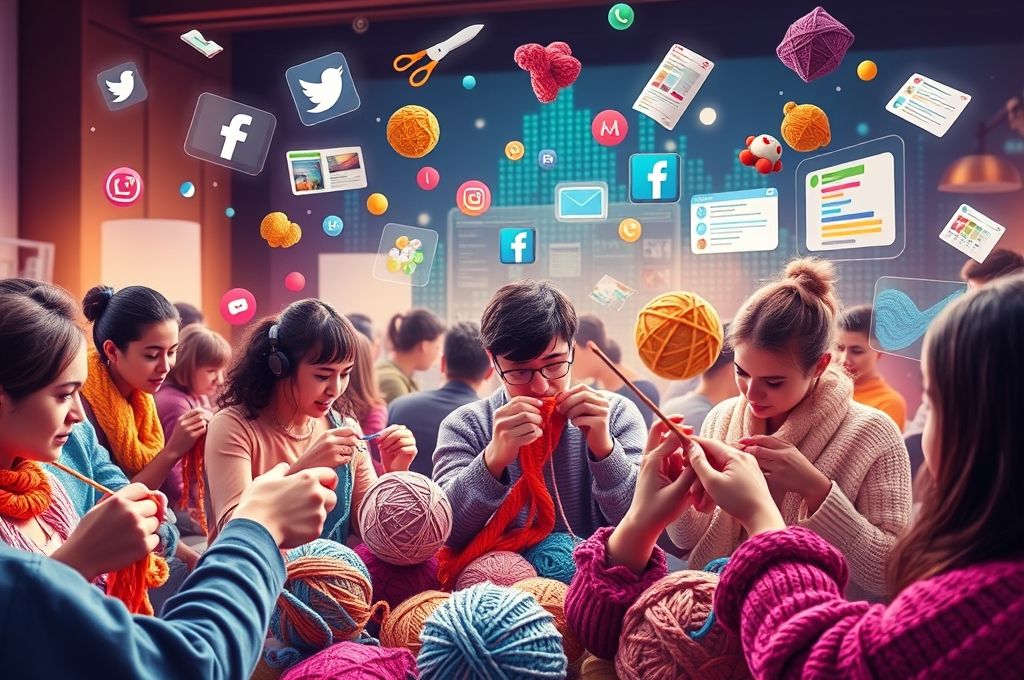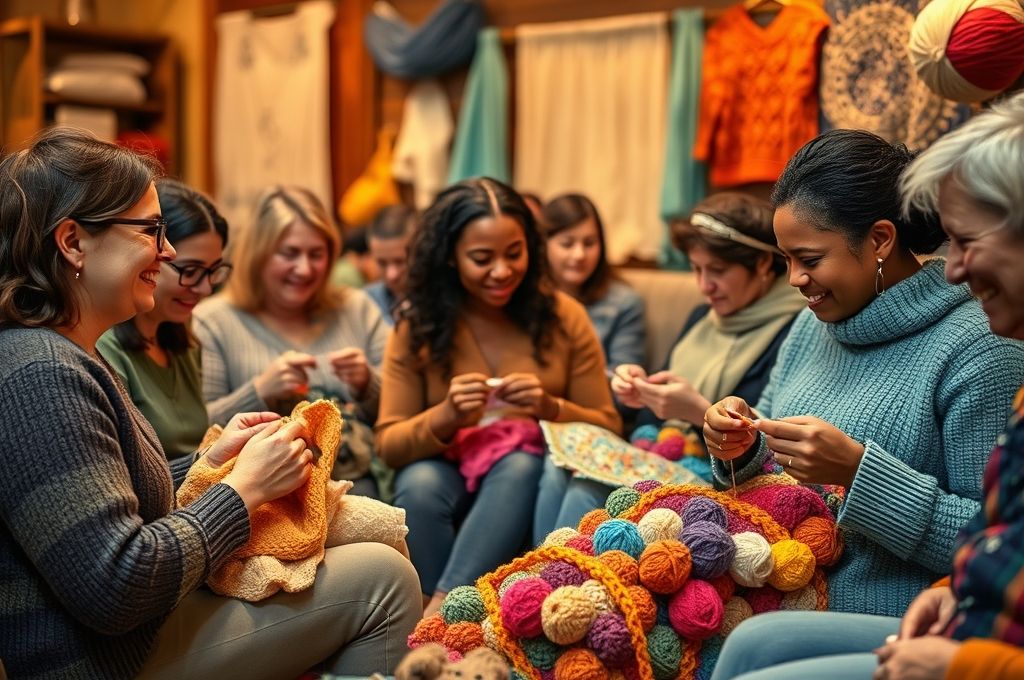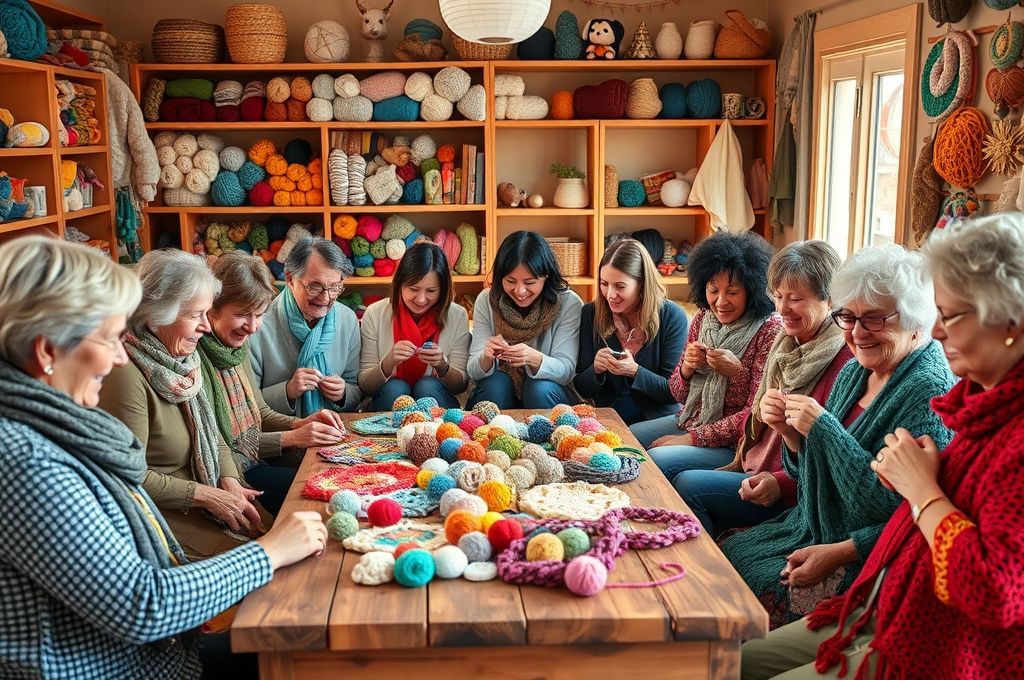Have you ever picked up a crochet hook and felt a quiet sense of calm wash over you? Maybe it was the rhythm of the stitches, the soft texture of the yarn, or the joy of watching a simple loop turn into something beautiful. But what if I told you that the real magic of crochet doesn’t just happen in your hands—it happens in your heart, when you connect with others who share your passion?
Crocheting is more than a craft—it’s a gateway to community. Whether you’re a beginner fumbling with your first chain stitch or a seasoned artisan creating intricate lace shawls, there’s a tribe out there waiting for you. And in today’s world, that tribe exists both online and offline, offering support, inspiration, and friendship to anyone willing to reach out.
In this article, we’ll explore how the crochet community has evolved into a vibrant, global network. We’ll dive into the benefits of joining crochet groups, both in person and on digital platforms, and share practical tips for finding your people. You’ll discover how connecting with fellow crocheters can boost your creativity, improve your skills, and even enhance your mental well-being. From local yarn shops to Instagram hashtags, from virtual stitch-alongs to craft fairs, we’ll guide you through the many ways you can belong.
So put down your project (just for a moment!), grab a cup of tea, and let’s explore how the simple act of looping yarn can weave you into a much larger, more meaningful story.
Why Community Matters in a Solo Craft
Crocheting is often seen as a solitary hobby. You sit with your yarn, your hook, and your thoughts—sometimes for hours. While that quiet time can be therapeutic, it can also feel isolating, especially when you hit a snag in a pattern or just want to share your latest creation with someone who truly gets it.
That’s where community comes in. Humans are wired for connection, and even introverts thrive when they feel seen and understood. A 2022 study published in the Journal of Positive Psychology found that engaging in creative hobbies with others significantly boosts feelings of happiness and reduces loneliness. For crafters, this is especially true—knowing you’re part of a group that shares your passion can transform a simple pastime into a source of deep fulfillment.
Think about it: when was the last time you showed someone your crochet work and they said, “Oh, that’s nice,” without really understanding the hours of effort behind it? Now imagine showing it to a room full of people who gasp, ask about your yarn choice, and immediately want to try the same stitch. That’s the power of community.
Beyond emotional support, being part of a crochet group opens doors to learning. Someone might show you a faster way to change colors, recommend a must-have ergonomic hook, or help you fix a dropped stitch. These small moments of shared knowledge are priceless.
So while crochet may start as a solo activity, it doesn’t have to stay that way. In fact, connecting with others might be the missing piece that turns your hobby into a lifelong joy.
The Rise of Online Crochet Communities

In the past, finding fellow crocheters meant relying on local craft stores, church groups, or word of mouth. Today, the internet has shattered those geographical barriers. With just a few clicks, you can join a global network of yarn lovers from Tokyo to Toronto, all united by their love of loops and stitches.
Platforms like Ravelry, Instagram, Facebook groups, and YouTube have become virtual hubs for crocheters. Ravelry, launched in 2007, remains a cornerstone of the online crochet world. It’s not just a pattern database—it’s a social network where users share project updates, join forums, and participate in “stitch-alongs” (SALs), where members work on the same pattern together over a set period.
Instagram, on the other hand, thrives on visual inspiration. Hashtags like #crochetcommunity, #handmadewithlove, and #yarnaddict connect millions of posts, making it easy to discover new techniques, color palettes, and creative ideas. Many crocheters have even turned their Instagram pages into small businesses, selling patterns or handmade goods directly to followers.
YouTube offers something different: education. Channels like Jayda InStitches, Bella Coco, and The Crochet Crowd provide free, step-by-step tutorials for every skill level. These creators don’t just teach—they build communities in the comments, where viewers ask questions, share modifications, and cheer each other on.
And let’s not forget TikTok, where short, engaging videos showcase time-lapses of amigurumi animals, trendy yarn hacks, and satisfying “before and after” reveals. It’s fast-paced, fun, and surprisingly supportive.
The beauty of online communities is their accessibility. Whether you’re a night owl in New Zealand or a mom squeezing in stitches during nap time in Texas, there’s always someone online who’s awake, crafting, and ready to chat.
How to Find Your Niche in the Digital Crochet World
With so many platforms and groups, it’s easy to feel overwhelmed. Where do you even begin? The key is to find your niche—a corner of the crochet world that resonates with your style, goals, and personality.
Start by asking yourself a few simple questions:
- Do you love making baby blankets or amigurumi toys?
- Are you drawn to bold, modern designs or traditional granny squares?
- Do you want to sell your work, learn advanced techniques, or just relax with a simple project?
Once you have a sense of your preferences, search for groups or hashtags that match. For example:
- #amigurumi for cute stuffed animals
- #grannysquare for classic patterns
- #crochetfashion for wearable art
- #yarnbombing for public art projects
Facebook groups are especially good for niche interests. Try searching for “Crocheters Who Love Mandalas” or “Left-Handed Crocheters.” You’ll likely find dozens of active communities. Many are moderated to keep the tone positive and spam-free, which makes them safe spaces for sharing and learning.
Ravelry allows you to join “groups” based on interests, locations, or skill levels. Some are project-based (“2024 Blanket Stitch-Along”), while others are support-focused (“Crocheters with Anxiety”).
And don’t underestimate the power of commenting. A simple “Love your color choice!” or “Can you share your pattern?” can spark a conversation that turns into a lasting connection.
Remember: you don’t have to join every group or follow every influencer. Start small. Lurk for a while, get a feel for the vibe, and then dip your toes in. Authenticity matters more than popularity. Your perfect tribe is out there—they’re just waiting for you to say hello.
The Magic of In-Person Crochet Gatherings

While online communities offer convenience and endless inspiration, there’s something irreplaceable about meeting fellow crocheters face to face. The warmth of a shared laugh, the sound of hooks clicking in unison, the smell of coffee and wool—these sensory experiences create memories that no screen can replicate.
Local yarn shops (LYS) are often the heart of offline crochet communities. Many host weekly “yarn nights” or “stitch and sip” events where people bring their projects, chat, and learn from each other. These gatherings are low-pressure and welcoming, perfect for beginners who might feel intimidated by online forums.
Craft fairs and fiber festivals are another fantastic way to connect. Events like the North American Handmade Yarn Fair (NAHYF) or local farmers’ markets often feature crochet vendors, workshops, and live demonstrations. You might walk away with a new favorite yarn, a signed pattern book, or even a handmade hook case from a fellow crafter.
Then there are craft retreats—weekend getaways dedicated entirely to creativity. Imagine spending three days in a cozy cabin with a group of crocheters, sharing meals, trading tips, and working on collaborative projects. These retreats foster deep connections and often lead to lasting friendships.
Even informal meetups can be powerful. Some crocheters organize “park and hook” sessions in public spaces, turning benches and picnic tables into impromptu craft circles. Others host crochet-themed potlucks or holiday swaps.
The benefit of in-person interaction? Immediate feedback, real-time troubleshooting, and the joy of seeing someone’s eyes light up when you compliment their work. Plus, there’s no substitute for feeling a yarn’s texture in person before buying it!
Building Confidence Through Shared Creativity
One of the most underrated benefits of joining a crochet community is the boost it gives to your confidence.
When you’re working alone, it’s easy to doubt yourself. “Did I do this stitch right?” “Is my tension too loose?” “Will anyone even like this?” These doubts can pile up, leading to frustration or even giving up altogether.
But in a supportive community, those fears start to fade. When someone says, “Your colorwork is amazing!” or “I love how you modified that pattern,” it validates your effort. And when you help someone else fix a mistake, you realize how far you’ve come.
Communities also encourage experimentation. Seeing others try bold new techniques—like tapestry crochet or 3D motifs—can inspire you to step outside your comfort zone. And if you fail? No problem. In a good group, mistakes are seen as part of the learning process, not something to hide.
Take Sarah, a crocheter from Oregon, who joined a Facebook group after years of crocheting in silence. “I was scared my work wasn’t good enough,” she shared. “But when I posted my first afghan, people were so kind. They gave me tips, praised my color choices, and even asked for the pattern. Now I teach beginner classes at my local library.”
This ripple effect—where encouragement leads to growth, which leads to teaching and giving back—is at the heart of the crochet community. It’s not just about making things; it’s about becoming the kind of person who creates, shares, and inspires.
From Hobby to Business: How Community Fuels Creativity and Commerce
For many crocheters, the journey doesn’t stop at personal projects. The community often becomes a launchpad for turning passion into profit.
Selling handmade items—whether on Etsy, at craft fairs, or through Instagram—can be intimidating at first. But online groups provide a safe space to learn the ropes. Members share tips on photography, pricing, shipping, and customer service. Some even organize collaborative sales or “bundle events” to help new sellers gain visibility.
Pattern designing is another path. With feedback from testers in Ravelry or Facebook groups, designers can refine their instructions, ensure clarity, and build a loyal following. Many successful indie designers started by sharing free patterns and gradually built a brand through consistent engagement.
And let’s not forget yarn companies. Brands like Lion Brand, Red Heart, and Paintbox Yarns actively collaborate with community creators, sponsoring make-alongs and featuring user-generated content. This not only promotes their products but strengthens the sense of belonging among crocheters.
Even if you don’t want to sell anything, being part of a creative economy is empowering. It shows that your craft has value—not just emotionally, but economically. And when you support other handmade sellers, you contribute to a culture of appreciation for slow, mindful creation in a fast-paced world.
Overcoming Isolation: Crochet as a Social Lifeline
For many people, crochet is more than a hobby—it’s a lifeline.
Consider retirees who’ve lost their daily social routines, parents navigating the loneliness of early parenthood, or individuals managing anxiety or depression. For them, joining a crochet group can be a form of gentle therapy.
A 2021 study by the University of Wollongong found that crafters who participated in group activities reported lower levels of stress and higher life satisfaction. The repetitive motion of crocheting has a meditative effect, while social interaction combats isolation.
Online communities are especially vital for those with mobility issues, chronic illness, or living in rural areas. One member of a Ravelry group shared, “I have fibromyalgia and can’t leave the house often. But logging in every night to see what everyone’s working on makes me feel connected. I’m not alone.”
Even brief interactions—like a “Good luck on your job interview!” comment on a project post—can lift someone’s spirits. The crochet community, at its best, operates on kindness, inclusivity, and mutual respect.
And in times of crisis, it rallies. During the pandemic, crocheters worldwide made blankets for healthcare workers, masks for communities in need, and memorial shawls for grieving families. These acts of collective care prove that a simple craft can carry profound meaning.
Tips for Getting Started: How to Join and Thrive
Ready to find your tribe? Here are some practical steps to help you begin:
✅ Start with one platform. Don’t try to join everything at once. Pick one—Instagram, Facebook, or Ravelry—and explore. Search for hashtags or groups that match your interests.
✅ Lurk before you leap. Spend a few days observing the tone, rules, and types of posts. This helps you understand the culture before jumping in.
✅ Introduce yourself. Most groups welcome new members with an intro thread. Share your name, where you’re from, and what you love to make. A photo of your latest project is a great icebreaker.
✅ Be kind and curious. Comment on others’ work. Ask questions. Celebrate milestones. Authentic engagement builds trust.
✅ Attend a local event. Check your LYS calendar, Meetup.com, or Facebook Events for crochet nights or workshops. Bring a project and a smile.
✅ Set boundaries. Not every group will feel like a fit. If a space feels toxic or overly competitive, it’s okay to leave. Your mental well-being comes first.
✅ Be patient. Building real connections takes time. Don’t expect instant friendships. Just show up, be yourself, and let the yarn do the rest.
Remember: every expert crocheter was once a beginner. Your journey matters, and your voice has value.
The Ripple Effect of Belonging
When you join the crochet community, you’re not just gaining friends or followers—you’re becoming part of a living, breathing culture of care.
Every stitch you share, every comment you leave, every project you post adds to a larger tapestry of connection. That baby blanket you made for a friend? It was crocheted with love—and that love multiplies when someone sees it and thinks, “I want to learn how to do that.”
The beauty of this community is that it’s self-sustaining. Newcomers are welcomed, skills are shared freely, and creativity is celebrated in all its forms. There’s no gatekeeping, no “right way” to crochet—just people helping people, one loop at a time.
And in a world that often feels divided, that’s something worth holding onto.
Conclusion: Your Hook, Your Tribe, Your Story
Crocheting is a quiet act of creation—but it doesn’t have to be a lonely one. Whether you’re scrolling through Instagram at midnight or laughing with strangers at a yarn shop meetup, you’re part of something bigger. The crochet community is alive, diverse, and deeply human.
We’ve explored how online spaces make connection possible across continents, how in-person gatherings bring warmth and authenticity, and how being part of a tribe can boost your confidence, creativity, and well-being. We’ve seen how this craft can heal, inspire, and even turn into a livelihood.
Now, it’s your turn.
Pick up your hook. Share your work. Say hello to someone new. You don’t need to be perfect. You just need to be present.
Because somewhere out there, someone is waiting to admire your stitches, learn from your journey, and call you friend.
So go ahead—find your tribe. The yarn’s ready, and so are they.
💬 Now we’d love to hear from you: Where have you found your crochet community? Online? At a local shop? Through a friend? Share your story in the comments and inspire others to connect!
And if you found this article helpful, don’t keep it to yourself—share it with a fellow crocheter who might need a little encouragement to join the circle.
Happy hooking! 🪝🧶

Daniele Ferreira is passionate about the world of crochet, dedicating her time to exploring techniques, creating unique pieces, and sharing her knowledge with beginners and aficionados alike. With attention to detail and creativity, she transforms yarn into true works of art, inspiring others to discover the beauty and joy of this manual art.







